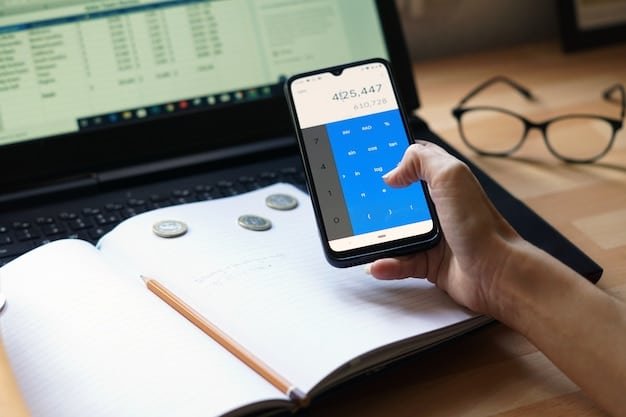BNPL: The Rise of Buy Now, Pay Later & Its Impacts on Credit

Buy Now, Pay Later (BNPL) services have surged in popularity, offering consumers a convenient way to finance purchases; however, while providing flexibility, BNPL can also significantly impact credit scores and financial stability if not managed responsibly, raising concerns about debt accumulation and financial literacy.
The appeal of instant gratification has found a new ally in the form of Buy Now, Pay Later (BNPL) services. But as this financing method gains traction, it is crucial to understand its potential impact on your credit health.
Understanding Buy Now, Pay Later (BNPL)
Buy Now, Pay Later (BNPL) has become a common payment option, especially for online shoppers. Understanding how it works is the first step to using it responsibly and protecting your credit score.
BNPL services offer short-term installment loans, often interest-free, to allow consumers to make purchases and pay them off over a few weeks or months. These services have gained popularity because they offer a convenient alternative to traditional credit cards, especially for smaller purchases.
How BNPL Works
The basic process of using a BNPL service involves a quick application and approval process, typically integrated directly into the online checkout page.
- Application and Approval: Most BNPL providers require a soft credit check, which doesn’t affect your credit score, to approve your application. The process is usually quick, providing an instant decision.
- Installment Plans: Once approved, you can split your purchase into several installments. The most common plans involve four bi-weekly payments, but other arrangements are available.
- Interest and Fees: Many BNPL services offer interest-free plans if you make payments on time. However, late fees can apply if you miss a payment deadline.
The convenience and instant approval of BNPL make it attractive to many consumers, particularly those who may not qualify for traditional credit cards or prefer to avoid high-interest rates.

Benefits of Using BNPL
BNPL services provide several advantages that attract a wide range of consumers, making them a popular alternative to traditional credit options.
- Interest-Free Options: Many BNPL plans offer 0% interest, making them a cost-effective way to finance purchases if you pay on time.
- Convenience: BNPL is integrated directly into the checkout process of many online retailers, offering a seamless payment experience.
- Accessibility: BNPL can be accessible to consumers with limited or no credit history, offering an alternative to traditional credit cards.
However, while the benefits are clear, it’s essential to weigh them against the potential risks. Responsible use of BNPL services requires careful budgeting and adherence to payment schedules to avoid negative consequences.
In conclusion, understanding the mechanics and benefits of BNPL can empower consumers to use these services effectively. By being informed and responsible, you can take advantage of the convenience and cost savings of BNPL without jeopardizing your financial health.
The Impact of BNPL on Credit Scores
While Buy Now, Pay Later (BNPL) services offer convenience and flexibility, it’s crucial to understand their potential impact on your credit score. Not all BNPL providers report to credit bureaus, which can create both opportunities and risks.
The primary concern is how BNPL affects your credit rating, either positively or negatively. This depends largely on whether the BNPL provider reports your payment behavior to the major credit bureaus.
Reporting Practices of BNPL Providers
The reporting habits of BNPL providers vary significantly. Some report both positive and negative payment behavior, while others only report negative information, such as late payments or defaults.
Experian, Equifax and TransUnion have started incorporating BNPL payment data into credit reports. As more data is gathered, lenders will have better understanding of your financial behaviour. When considering risks associated with BNPL, its important to evaluate if lender shares the data.
- No Reporting: Some BNPL providers do not report to credit bureaus at all, meaning your on-time payments will not help build your credit, but late payments won’t directly hurt it either.
- Negative Reporting Only: Others report only negative information, such as late payments or defaults, which can negatively impact your credit score.
- Comprehensive Reporting: A few BNPL providers report both positive and negative payment behavior, allowing you to build credit with responsible use.
Knowing the reporting practices of your BNPL provider is essential. This information is typically available in the terms and conditions of the service.
How BNPL Can Negatively Affect Credit
Several factors can cause BNPL usage to negatively impact your credit score. It’s important to be aware of these risks and take steps to avoid them.

- Late Payments: The most common way BNPL can hurt your credit is through late payments. Even if the provider doesn’t report to credit bureaus, late fees can add up quickly and lead to debt collection.
- Debt Accumulation: Using multiple BNPL services can lead to overspending and debt accumulation. If you have trouble managing multiple payment schedules, it can lead to missed payments and negative credit consequences.
- Hard Credit Checks: While most BNPL providers perform soft credit checks, some may conduct hard inquiries, especially for larger purchase amounts. Hard inquiries can slightly lower your credit score.
Responsible use of BNPL involves making payments on time, avoiding overspending, and understanding the terms and conditions of each service.
In summary, the impact of BNPL on your credit score depends on the reporting practices of the provider and your payment behavior. Stay informed and responsible to protect your credit health.
The Role of BNPL in the Financial Ecosystem
Buy Now, Pay Later (BNPL) services are not just a passing trend; they are rapidly evolving into a significant part of the financial ecosystem. Understanding their place in the market and their effects on both consumers and businesses is essential.
BNPL has carved out a unique space by offering an alternative to traditional credit. This has implications for consumers, retailers, and the broader financial industry.
Impact on Retailers
BNPL services have a notable impact on retailers, influencing sales, customer loyalty, and average order values.
For retailers, BNPL offers several advantages:
- Increased Sales: BNPL can boost sales by making purchases more accessible to a broader range of customers.
- Higher Order Values: Customers may be more inclined to make larger purchases when they can spread the cost over time.
- Customer Loyalty: Offering BNPL can enhance customer satisfaction and loyalty by providing a convenient payment option.
However, retailers also face some challenges, such as the fees charged by BNPL providers, which can impact profit margins. It’s crucial for retailers to weigh the benefits against the costs when integrating BNPL into their payment systems.
BNPL vs. Traditional Credit Cards
BNPL has emerged as a competitor to traditional credit cards, particularly for younger consumers and those with limited credit history. While both options offer financing, there are critical differences.
The primary difference lies in:
- Approval Process: BNPL often has a more straightforward and faster approval process compared to credit cards.
- Interest Rates: Many BNPL plans offer 0% interest, while most credit cards charge interest on unpaid balances.
- Credit Building: Credit cards, when used responsibly, can help build credit, whereas the impact of BNPL on credit depends on the provider’s reporting practices.
Future Trends in BNPL
The BNPL industry is expected to continue evolving. Several trends are likely to shape its future, including:
The future of BNPL includes:
- Increased Regulation: As BNPL grows, regulatory scrutiny is likely to increase to protect consumers and ensure fair lending practices.
- Integration with Financial Products: BNPL may become integrated with other financial products, such as budgeting apps and credit monitoring services.
- Expansion into New Markets: BNPL is likely to expand into new industries and markets, offering financing for everything from travel to healthcare.
In conclusion, BNPL services are playing an increasingly significant role in the financial ecosystem. The services have the potential to reshape consumer spending habits and influence the broader financial landscape. By staying informed about these trends, consumers and businesses can make the most of the opportunities BNPL offers while mitigating the risks.
Responsible BNPL Usage: Dos and Don’ts
Buy Now, Pay Later (BNPL) can be a useful financial tool if used responsibly. However, it’s easy to fall into the trap of overspending or mismanaging payments. Knowing the dos and don’ts of BNPL can help you avoid potential pitfalls and make the most of its benefits.
Responsible BNPL usage involves careful planning, budgeting, and adherence to payment schedules. Here are some guidelines to help you navigate BNPL safely.
Dos of BNPL Usage
Following these guidelines can help ensure you use BNPL in a way that benefits your financial health:
- Do Budget Carefully: Before making a BNPL purchase, ensure you have a clear budget and can comfortably afford the installment payments.
- Do Understand the Terms: Read and understand the terms and conditions of the BNPL service, including interest rates, late fees, and reporting practices.
- Do Set Up Payment Reminders: Set up reminders to ensure you don’t miss payment deadlines. Many BNPL apps offer automatic payment options, which can be helpful.
Being proactive and informed can help you avoid potential issues and take full advantage of the benefits BNPL offers.
Don’ts of BNPL Usage
These practices can lead to financial difficulties:
Avoiding these common mistakes can help you maintain your financial health and avoid negative consequences.
- Don’t Overspend: Avoid using BNPL to make impulse purchases or buy items you can’t afford. Overreliance on BNPL can lead to debt accumulation.
- Don’t Use Multiple Services: Using multiple BNPL services simultaneously can make it difficult to track payments and manage your finances.
- Don’t Ignore Late Fees: Late fees can add up quickly and significantly increase the cost of your purchase. Always prioritize making payments on time.
By avoiding these pitfalls, you can use BNPL responsibly and minimize potential risks. Responsible BNPL use is all about balance, awareness, and discipline.
In conclusion, responsible BNPL usage requires careful planning, budgeting, and adherence to payment schedules. By following the dos and don’ts outlined above, you can take advantage of the convenience and cost savings of BNPL without jeopardizing your financial health.
Alternatives to BNPL
While Buy Now, Pay Later (BNPL) offers a convenient way to finance purchases, it is not the only option available. Exploring alternatives can provide more flexible and potentially more cost-effective solutions. Considering the different advantages and disadvantages can help choose what best suites individual needs.
Understanding alternative payment methods is key to maintaining financial health and making the best financial decisions. There are various alternative one could consider, each with its pros and cons.
Credit Cards
Credit cards are perhaps the most well-known alternative to BNPL. However, one should consider the pros and cons, so as to make the best decision:
Credit cards offer flexible financing and can be a great tool if used carefully:
- Pros:
- Can help build credit when used responsibly.
- Many cards offer rewards points or cashback on purchases.
- Emergency coverage for a wide range of expenses.
- Cons:
- High interest rates can result in greater cost of debt.
- Fees and overspending can impact the credit rating.
- Approval process may not be as easy comparing to BNPL.
Personal Loans
Personal loans are another alternative, particularly for big purchases or debt consolidation:
Personal loans suit larger expenses and offer fixed repayment plans.
- Pros:
- Lower interest rates than credit cards, especially for borrowers with good credit.
- Fixed payment schedules, making budgeting easier.
- Can be used for a wide range of purposes, from debt consolidation to home improvements.
- Cons:
- Often requires a good credit score for approval.
- May involve origination fees or prepayment penalties.
Savings and Budgeting
An even more practical strategy to avoid debt: saving and budgeting.
- Pros:
- Avoids interest and fees altogether.
- Promotes financial discipline and awareness.
- Can lead to better financial habits in the long run.
- Cons:
- Requeires one to plan ahead and practice financial disciple.
Each of these alternatives has its own set of advantages and disadvantages. In the end, an informed individual can choose the most suitable payment method.
Conclusion
BNPL has revolutionized the ability to purchase goods and services. While it offers the benefit of convenience, it’s important to understand how it can affect a person’s credit score. As more BNPL services emerge, it is important to know the details of each service and if they report to credit bureaus. Remember to budget responsibly to maximize the reward and reduce potential risks of damaging one’s credit score.
| Key Point | Brief Description |
|---|---|
| 🛒 BNPL Basics | Short-term loans, often interest-free, split payments over weeks/months. |
| 💰 Credit Impact | Credit scores affected by reporting habits of providers; late payments hurt. |
| 📈 Retail Role | Boosts sales, increases order values, and enhances customer loyalty for retailers. |
| ✅ Responsible Use | Budget carefully, understand terms, and avoid overspending with BNPL. |
Frequently Asked Questions
▼
▼
▼
▼
▼
Conclusion
In conclusion, the rise of Buy Now, Pay Later (BNPL) services presents both opportunities and challenges for consumers. The key to navigating this evolving landscape is to stay informed about the benefits and risks, use BNPL responsibly, and understand its potential impact on your credit health. Use responsibly and be informed.





